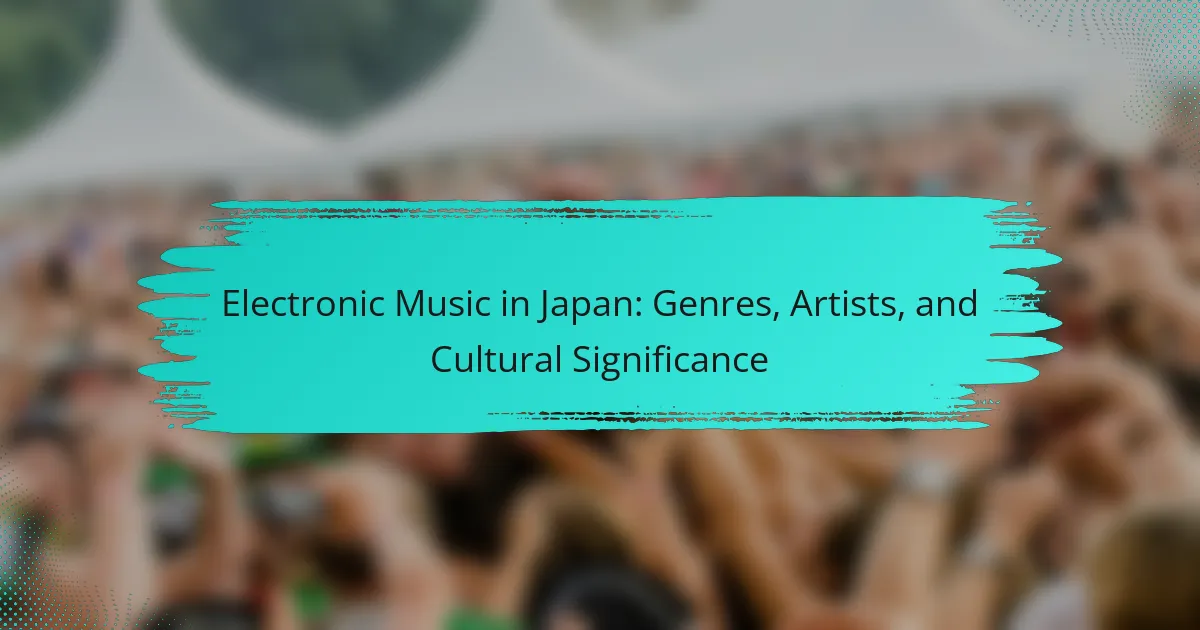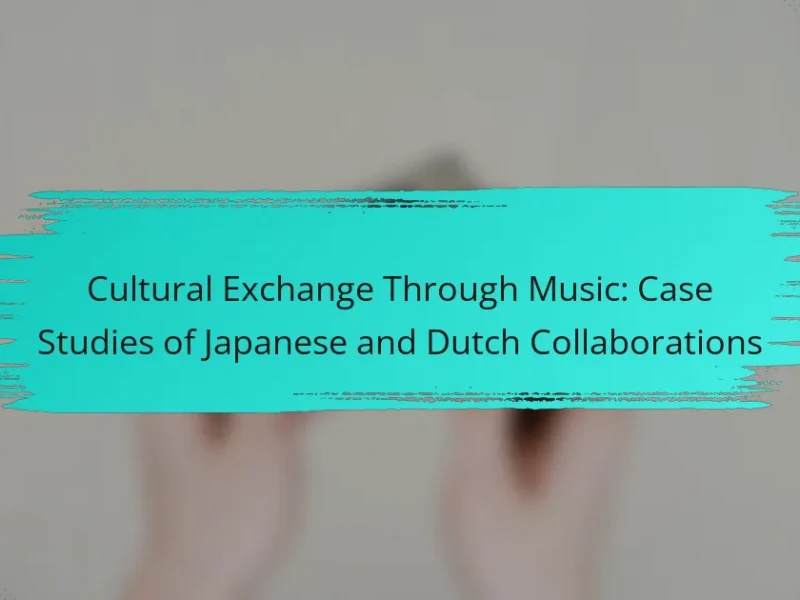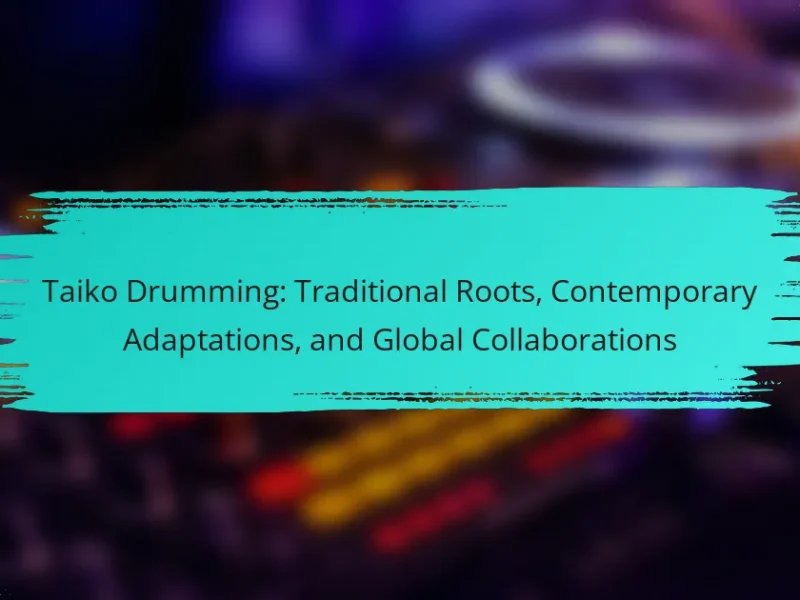Electronic music in Japan is a dynamic and influential force, shaped by genres like techno, house, and J-pop influenced electronic. Key artists such as Ryuichi Sakamoto and Ken Ishii have made significant contributions, blending traditional Japanese elements with modern sounds. This genre reflects Japan’s cultural identity and societal changes, while also facing challenges in acceptance and promotion. The evolving scene showcases innovative trends and highlights the importance of electronic music festivals in uniting diverse audiences.

What are the key genres of electronic music in Japan?
The key genres of electronic music in Japan include techno, house, trance, and J-pop influenced electronic. Techno emerged in the 1980s, characterized by repetitive beats and synthesized sounds. House music blends elements of disco and funk, gaining popularity in clubs. Trance focuses on melodic phrases and build-ups, often creating euphoric experiences. J-pop influenced electronic incorporates pop sensibilities with electronic production, appealing to a wider audience. Each genre contributes to Japan’s vibrant electronic music scene, reflecting cultural trends and technological advancements.
How did techno evolve within the Japanese music scene?
Techno evolved in Japan through the fusion of local musical influences and global electronic trends. In the 1980s, artists like Ken Ishii integrated techno with traditional Japanese sounds, creating a unique genre. The 1990s saw the rise of events like the “Rave Movement,” which popularized techno in urban areas. By the 2000s, Japanese techno gained international recognition, with artists such as DJ Nobu and Soichi Terada showcasing their work globally. This evolution reflects Japan’s adaptability and innovation within the electronic music scene, emphasizing the blend of cultural significance and genre diversity.
Which elements define J-Pop influenced electronic music?
J-Pop influenced electronic music is defined by its fusion of catchy melodies, vibrant production, and diverse genres. Key elements include the use of synthesizers, incorporation of pop sensibilities, and a strong emphasis on visual aesthetics. Artists often blend traditional Japanese instruments with modern electronic sounds, creating a unique cultural expression. Collaborations between J-Pop artists and electronic producers further enhance this genre’s distinctiveness.
What role does ambient music play in Japanese culture?
Ambient music plays a significant role in Japanese culture by enhancing environments and influencing emotional experiences. It is often used in public spaces, such as cafes and art galleries, to create a calming atmosphere. Japanese ambient music incorporates traditional elements, blending them with modern electronic sounds. This fusion reflects a unique cultural identity, emphasizing tranquility and nature. Artists like Hiroshi Yoshimura and Ryuichi Sakamoto have shaped the genre, contributing to its global recognition. The music serves as a backdrop for meditation and relaxation, highlighting its importance in Japanese daily life.
How do traditional Japanese instruments integrate into electronic music?
Traditional Japanese instruments, like the shamisen and koto, enhance electronic music by adding unique textures and cultural depth. Artists blend these instruments with digital sounds, creating innovative genres that reflect Japan’s rich musical heritage. This fusion allows for a diverse range of emotional expression and showcases the adaptability of traditional art forms in contemporary contexts. Collaborations between electronic producers and traditional musicians have led to a resurgence of interest in these instruments, bridging generational gaps and expanding audiences.
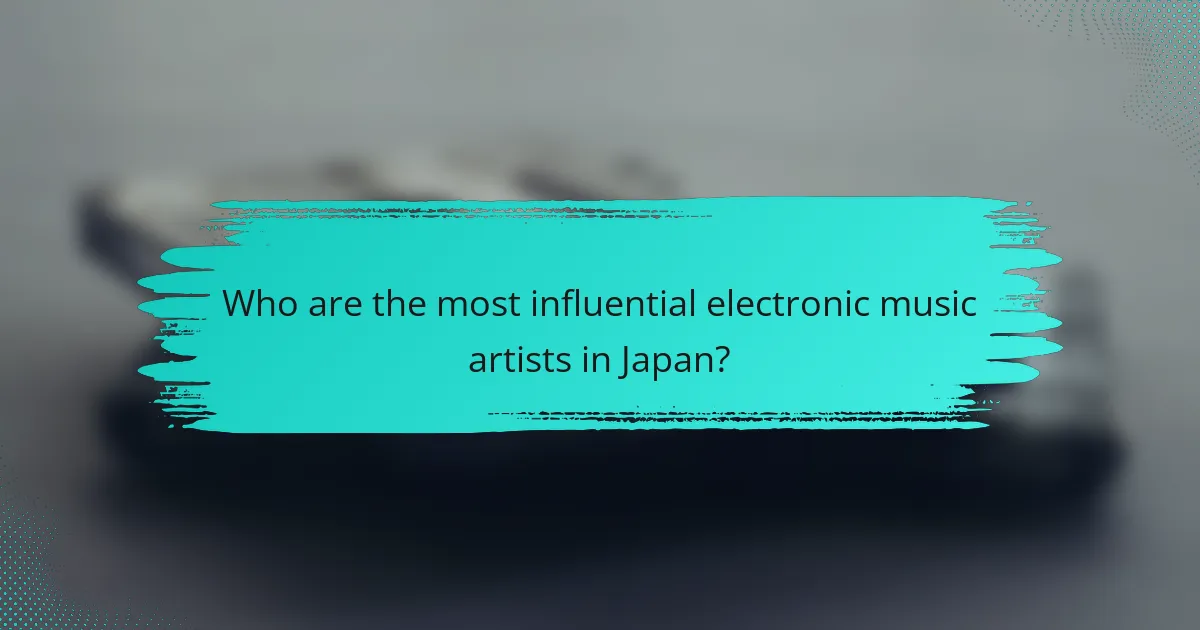
Who are the most influential electronic music artists in Japan?
The most influential electronic music artists in Japan include Ryuichi Sakamoto, Ken Ishii, and Daft Punk’s influence on local acts. Ryuichi Sakamoto blends traditional Japanese music with electronic elements, creating unique soundscapes. Ken Ishii is known for his techno contributions, particularly his 1995 album “Garden on the Palm.” Additionally, artists like Aoki Takamasa and DJ Krush have significantly shaped the genre with their innovative styles. These artists have not only influenced the electronic music scene in Japan but have also gained international recognition.
What contributions has Ken Ishii made to the genre?
Ken Ishii has significantly influenced the electronic music genre in Japan through innovative sound design and pioneering techno. His work integrates traditional Japanese elements with modern electronic techniques, creating a unique auditory experience. Ishii’s album “Jelly Tones” showcased his ability to blend genres, earning him international recognition. Additionally, he played a crucial role in popularizing techno music within Japan, inspiring a new generation of artists. His contributions extend to live performances, where he combines visual art with music, enhancing the overall cultural significance of electronic music in Japan.
How has Ryoichi Kurokawa shaped audiovisual performances?
Ryoichi Kurokawa has significantly influenced audiovisual performances by merging technology and art. His innovative approach integrates real-time visuals with electronic music, creating immersive experiences. Kurokawa’s work exemplifies the unique attribute of synesthetic art, where sound and visuals coalesce seamlessly. His performances often utilize advanced projection techniques and generative algorithms, enhancing the cultural significance of electronic music in Japan. As a result, he has become a pivotal figure in shaping the contemporary landscape of digital art and music.
Which emerging artists are gaining recognition in 2025?
In 2025, artists like Kero Kero Bonito, Aimer, and Tofubeats are gaining recognition in Japan’s electronic music scene. Their innovative sounds blend genres, pushing cultural boundaries. Kero Kero Bonito combines pop with electronic elements, while Aimer’s ethereal vocals enhance electronic beats. Tofubeats is known for his unique fusion of J-pop and house music, showcasing the diversity within the genre. These artists reflect Japan’s vibrant electronic music culture, contributing to its global influence.

How does electronic music reflect Japan’s cultural identity?
Electronic music in Japan reflects the country’s cultural identity through its fusion of traditional sounds and modern technology. This genre often incorporates elements of Japanese folklore, instruments, and aesthetics, creating a unique auditory experience. Artists like Ryuichi Sakamoto and Ken Ishii blend these influences, showcasing Japan’s innovation and heritage. The genre’s evolution mirrors societal changes, emphasizing Japan’s adaptability and global influence in music. Electronic music festivals, such as Fuji Rock, further highlight this cultural significance, uniting diverse audiences and promoting artistic expression.
In what ways does electronic music connect with youth culture?
Electronic music connects with youth culture through its innovative sounds, vibrant festivals, and digital accessibility. Genres like J-pop and techno resonate with young audiences, fostering community and self-expression. Artists such as Kyary Pamyu Pamyu and Daft Punk influence fashion and lifestyle trends. Additionally, electronic music often addresses themes of freedom and rebellion, appealing to youth’s desire for identity and connection.
How do festivals and events celebrate electronic music in Japan?
Festivals and events in Japan celebrate electronic music through immersive experiences and diverse lineups. Major festivals like Ultra Japan and Fuji Rock showcase both international and local artists, emphasizing genres like techno, house, and trance. These events foster community engagement, attracting thousands of fans and highlighting Japan’s unique electronic music culture. Additionally, local clubs and pop-up events promote underground talent, ensuring a vibrant scene that evolves continuously. This blend of mainstream and underground reflects the cultural significance of electronic music in Japan, bridging traditional and modern influences.
What impact does electronic music have on Japanese visual arts?
Electronic music significantly influences Japanese visual arts by inspiring innovative aesthetics and multimedia collaborations. The fusion of sound and image creates immersive experiences that challenge traditional art forms. Artists like Ryoji Ikeda and Takashi Murakami incorporate electronic music elements into their work, enhancing emotional depth and audience engagement. This synergy fosters a dynamic cultural exchange, reflecting Japan’s unique position in the global electronic music scene.
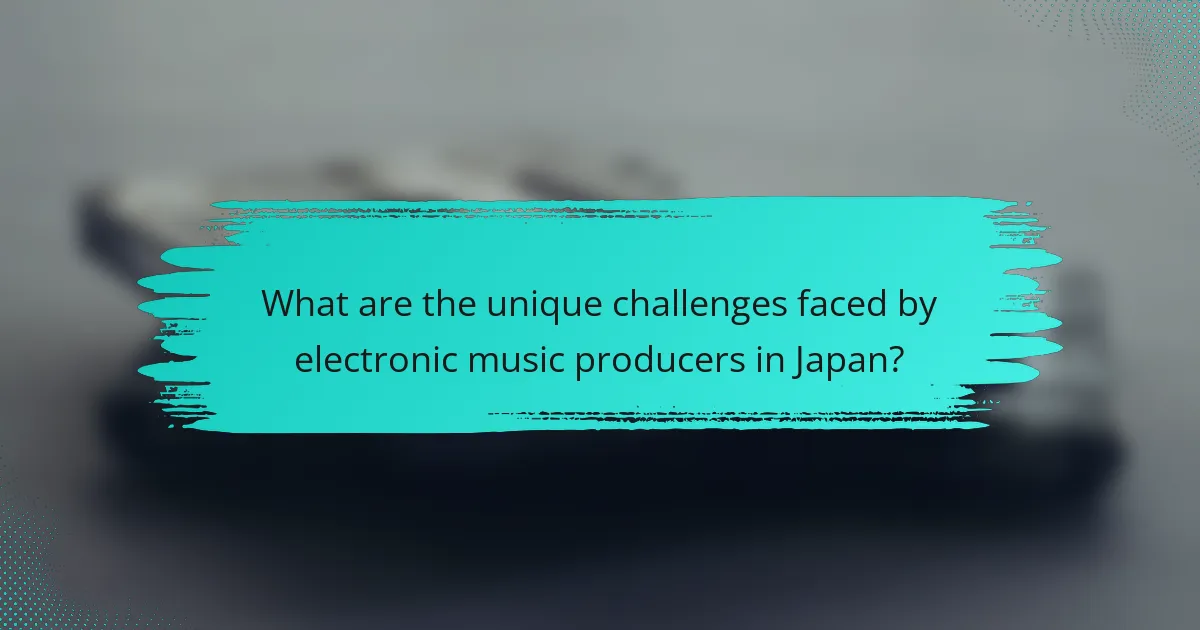
What are the unique challenges faced by electronic music producers in Japan?
Electronic music producers in Japan face unique challenges such as cultural barriers, limited venues, and competition from traditional music genres. The distinct cultural landscape influences acceptance and promotion of electronic music. Additionally, the lack of dedicated spaces for live performances restricts exposure. Competition with established genres like J-Pop can overshadow emerging electronic artists. These factors create a complex environment for producers striving to innovate and gain recognition.
How do copyright laws affect music distribution?
Copyright laws significantly influence music distribution in Japan by protecting artists’ rights while regulating the use of their works. These laws ensure that electronic music creators receive royalties and maintain control over their music. The unique attribute of Japan’s copyright framework includes a strong emphasis on moral rights, allowing artists to protect their reputation and integrity. As a result, unauthorized distribution or remixing of music can lead to legal repercussions, impacting how electronic music is shared and consumed. This balance between protection and accessibility shapes the cultural significance of electronic music in Japan.
What are the financial hurdles for independent artists?
Independent artists in Japan face significant financial hurdles, including limited access to funding, high production costs, and inadequate revenue from streaming platforms. These challenges hinder their ability to produce and promote electronic music effectively.
The competitive nature of the Japanese music industry often leads to decreased opportunities for independent artists. Many struggle with marketing their work, leading to low visibility and sales.
Additionally, the reliance on live performances for income is complicated by high venue fees and fluctuating audience attendance. Artists must navigate these financial obstacles while striving to maintain their creative integrity.
Overall, the financial landscape for independent electronic musicians in Japan requires innovative strategies and community support to thrive.
How does the Japanese market differ from global trends?
The Japanese market for electronic music showcases distinct trends compared to global movements. Japan emphasizes unique genres like J-Pop and City Pop, blending traditional elements with electronic sounds. Local artists often prioritize cultural themes, leading to a more localized consumer experience. Additionally, Japan’s live music scene is heavily influenced by anime and gaming, which significantly shapes audience engagement. This cultural significance contributes to a market that values authenticity and local identity over broader global trends.
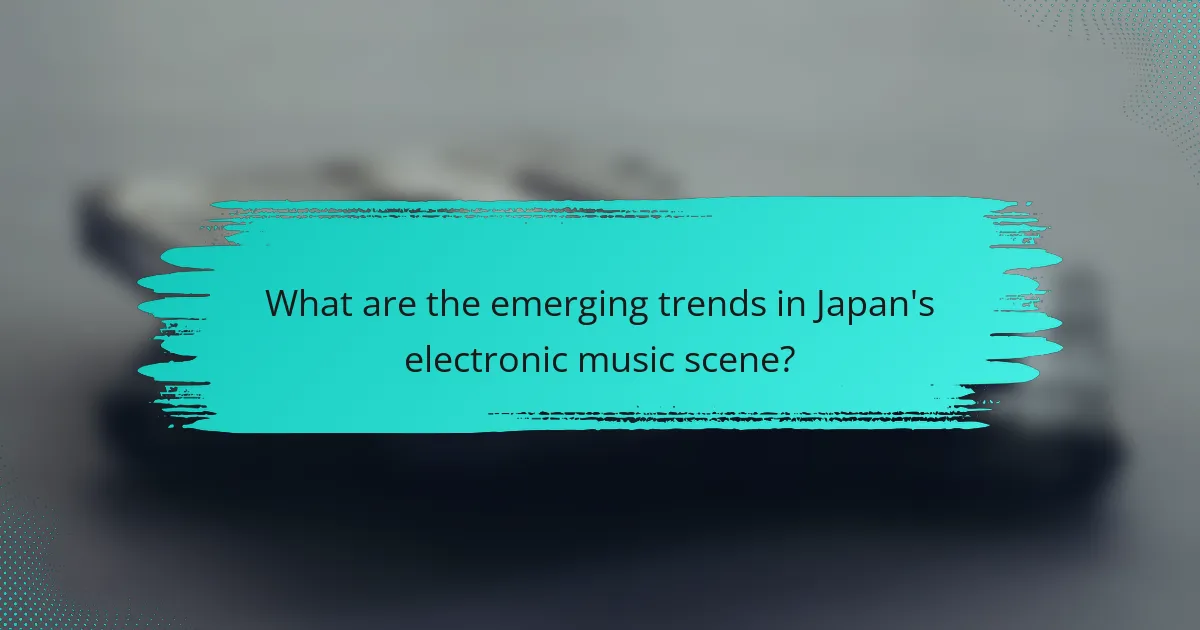
What are the emerging trends in Japan’s electronic music scene?
Japan’s electronic music scene is experiencing a vibrant evolution characterized by diverse genres and innovative artists. Notable trends include the rise of hyperpop, integration of traditional Japanese instruments, and increased global collaborations. Artists like Kyary Pamyu Pamyu and DJ Krush are pushing boundaries, blending cultural elements with electronic sounds. The scene’s cultural significance is amplified by its role in youth identity and social movements, reflecting broader societal changes.
How is technology influencing music production techniques?
Technology significantly influences music production techniques in Japan by enhancing creativity and accessibility. Digital audio workstations (DAWs) and software synthesizers have revolutionized how artists create and manipulate sound. This shift allows for experimentation with genres like J-Pop and electronic music, fostering innovation.
Artists such as Cornelius and Kyary Pamyu Pamyu exemplify this evolution, blending traditional Japanese elements with cutting-edge technology. The use of sampling and looping techniques, enabled by technology, has become a hallmark of Japanese electronic music.
Furthermore, online platforms facilitate collaboration and distribution, allowing artists to reach global audiences. This accessibility has transformed the music landscape, making it easier for emerging talents to showcase their work. As a result, technology continues to shape the cultural significance of music production in Japan.
What role do social media platforms play in artist promotion?
Social media platforms are crucial for artist promotion in Japan’s electronic music scene. They enable artists to connect directly with fans, share new music, and build a personal brand. Platforms like Twitter, Instagram, and TikTok amplify visibility and engagement, allowing artists to showcase their unique styles and cultural significance. Additionally, social media facilitates collaboration among artists, fostering a vibrant community that enhances the overall electronic music culture in Japan.
Which collaborations are reshaping the genre landscape?
Collaborations between artists, producers, and technology innovators are reshaping the electronic music genre in Japan. Notable partnerships include the fusion of traditional Japanese instruments with modern electronic sounds, creating unique sub-genres. For example, collaborations between artists like Ken Ishii and various visual artists enhance live performances. Additionally, cross-genre projects, such as those involving J-Pop and EDM, are gaining traction, broadening audience appeal. These collaborations not only innovate sound but also deepen cultural significance, reflecting Japan’s dynamic music landscape.
What are best practices for aspiring electronic music artists in Japan?
Aspiring electronic music artists in Japan should focus on networking, developing a unique sound, and understanding the local scene. Collaborate with other musicians and attend industry events to build connections. Invest time in mastering production software and hone your skills through practice. Engage with social media to promote your work and reach wider audiences. Additionally, study the cultural significance of electronic music in Japan, as it can influence your artistic direction and audience engagement.
